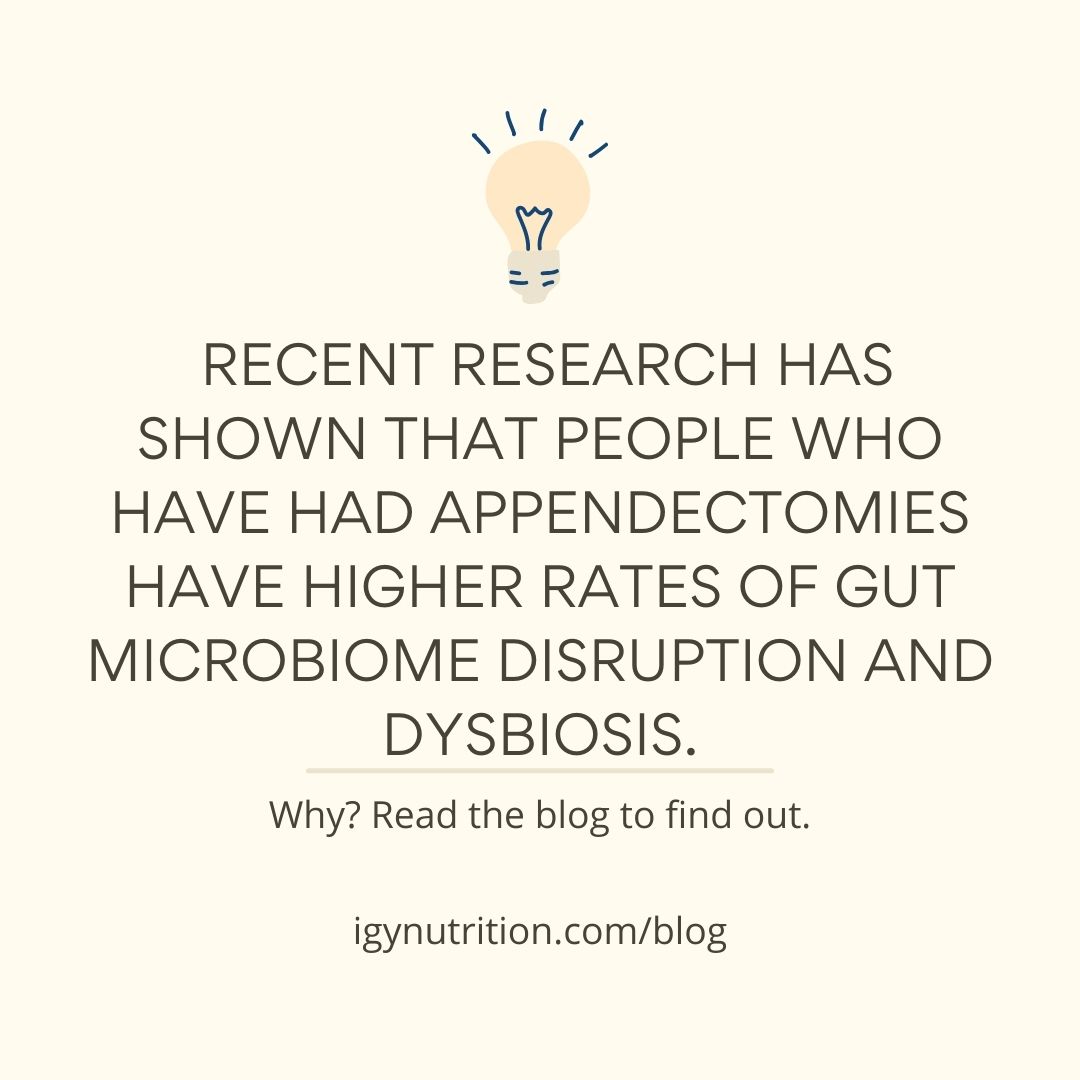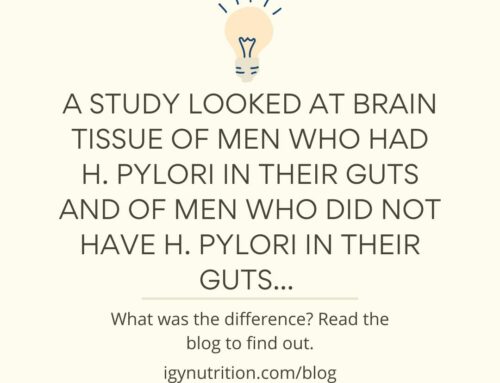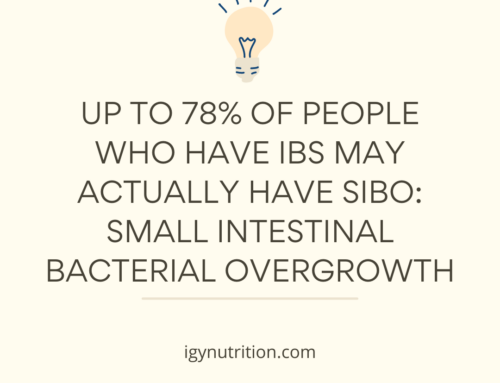The appendix, once thought to be a vestigial organ (meaning, an organ that does not serve a purpose), has recently been discovered to play a vital role in repopulating the gut microbiome after episodes of sickness.
You might be thinking – well, don’t people live perfectly normal, healthy lives after having their appendix removed?
Yes, they do and can. However, recent research has shown that people who have had appendectomies have higher rates of gut microbiome disruption and dysbiosis.
Today, we’ll talk about the appendix’s role and what someone who has had it removed can do to protect their gut health.
The Appendix and the Gut Microbiome
First off – what is the appendix?
The appendix is a small organ located at the junction of the small and large intestines. It used to be thought of as useless – if people had it removed, they seemed to be perfectly healthy afterward.
Why have the appendix removed in the first place? Sometimes, if a bit of you-know-what can get wedged in the lining of the appendix, an excessive amount of bacteria can populate it and cause significant swelling, which may cause it to burst. This is called appendicitis. If the appendix bursts, lots of dangerous bacteria will escape from it and can make you dangerously sick.
But, recent studies have shown that the appendix acts as a shelter of sorts for beneficial gut bacteria.
Let’s say you get some sort of terrible gut infection, like food poisoning. Events like those can greatly deplete probiotics living in the gut microbiome. So – how does your body bring things back into balance?
One study published in Nature found that the appendix seems to play a role by releasing these “backup” probiotics, such as Lactobacillus and Bifidobacterium, from itself. The probiotic microbes leave the appendix and repopulate your large intestine, bringing your microbiome back into balance.
Another study published in PLOS Biology found that it’s a popular breeding ground for the beneficial microbe population Bacteroidetes, which seems to reduce the risk of inflammatory bowel disease.
What if I’ve Had My Appendix Removed?
If you’ve had your appendix removed – don’t freak out. Achieving a healthy gut microbiome is still possible. You may just need to pay more attention to it than the average Joe.
First off, if you ever get a stomach-related sickness like food poisoning, make sure to take plenty of probiotics and eat fermented foods. According to this new research, it seems that your body may struggle to repopulate the microbiome with probiotics.
Secondly, preventing dysbiosis and SIBO from developing is key. To do that, you’ll want to suppress populations of dysbiotic microbes. Read on to find out how to do that.
Quick Recap: What is Dysbiosis?
You might already know a bit of microbiome science, but here’s a quick recap.
The microbiome is an ecosystem of millions of microbes – like bacteria, yeasts, and even fungi – living within or on the human body. The term “gut microbiome” refers to the microbes inhabiting the GI tract.
At first glance, microbes living in the body might sound pretty gross – but it turns out they’re necessary for our survival. Many of the microorganisms living within us benefit our bodies by regulating our metabolism, helping us absorb vitamins from food, supporting our immune system, and much more.
The thing is, not all of the microorganisms in our microbiomes are helpful. Some are harmful. These harmful microbes can damage the gut barrier, increase inflammation, and wreak havoc on our metabolisms, hormone production, immune systems, and mental health.
Plus, they can cause uncomfortable digestive issues like gas, bloating, and stool irregularity – no fun.
To minimize the gut damage and annoying symptoms the harmful microbes cause and maximize the benefits helpful microbes confer, we want many beneficial microbes and very few harmful microbes to live in our guts.
There are typically too many harmful microbes and not enough helpful microbes in an unhealthy microbiome. This state of imbalance is called dysbiosis.
Many scientists argue that dysbiosis, an imbalanced gut microbiome, is likely the culprit of most digestive health issues in America.
Check out our blog titled “Is My Microbiome Imbalanced” to find out whether you might have dysbiosis.
Overcoming Dysbiosis
To overcome dysbiosis, you’ll want to:
- Eliminate the harmful pathogens living in your gut microbiome
- Keep the helpful microbes already living in your gut microbiome
- Increase populations of helpful microbes living in your gut microbiome
You might already be familiar with strategies for keeping and increasing populations of helpful microbes in your gut microbiome, like:
- Consuming probiotics
- Eating fiber
- Eating fermented food
- Exercising
- Avoiding hefty doses of antibiotics
We’ve heard that all before. But what about the first piece of the equation? How do we eliminate harmful pathogens living in our gut microbiomes?
Getting Rid of the Bad Guys: Antibiotics?
Traditional treatment for dysbiosis typically involves antibiotics to clear the “bad” bacteria. The goal is to get rid of the bad bacteria that cause symptoms.
Antibiotics are the first-line treatment for dysbiosis, but they are often ineffective. In fact, studies have shown that antibiotics only work in about 50% of dysbiosis cases.
This may be due to the fact that antibiotics kill both good and bad bacteria, leading to an imbalance in gut flora. As a result, other treatment options, such as probiotics or herbals, may be more effective in treating dysbiosis.
Getting Rid of the Bad Guys: Herbal Therapies?
Probiotics and other natural therapies, such as herbs, may be as or more effective in restoring the balance of gut bacteria and treating dysbiosis, but there are a few caveats (1).
They may be less risky, but some studies show that they are not much more effective than antibiotics. They are also prohibitively expensive for many patients. More research is needed to evaluate their level of efficacy.
Many scientists argue that one of the main reasons dysbiosis is so difficult to treat is that it can be caused by a variety of different bacteria. Perhaps herbal treatments work well for one strain but not another.
It seems that there aren’t many great options – or are there?
Getting Rid of the Bad Guys: IgY Antibodies?
IgY antibodies have been proven to neutralize and remove several of these pathogens from consumers’ guts.
Scientists at IgY Nutrition realized that IgY antibodies could be used to address dysbiosis by neutralizing well-known bad actors in gut microbiomes. So, they created IgY Max.
IgY Max is a specifically immunized egg-based supplement containing antigen-specific antibodies that target and neutralize 29 dysbiotic pathogens commonly found in the human gut microbiome, including Klebsiella pneumoniae, Salmonella, various strains of Staphylococcus and Streptococcus, and other strains associated with SIBO.
In non-science speak: IgY Max is a supplement (made of only egg yolk) containing antibodies that neutralize pathogens living in the gut. These pathogens could contribute to your digestive symptoms if you have them.
Upon consumption, IgY Max antibodies exert their anti-pathogenic activity throughout the entire length of the gastrointestinal tract. They have a high pathogen-antibody affinity and inhibit bacterial adhesion, suppress colonization, and neutralize each targeted pathogen thoroughly. Neutralized pathogens are expelled from the gut through the stool (your poop!).
The product’s elimination of pathogens allows beneficial microbes to flourish, which may help to restore microbial diversity to the microbiome and rebalance it. This positive shift in microbiome composition reduces dysbiotic pathogens’ initiation of gastrointestinal damage and amplifies healthy flora’s conferral of gastrointestinal benefits.
University-led studies of IgY Max confirm this, showing that IgY Max consumers’ beneficial flora, gut barrier integrity, and inflammation levels improved significantly over eight weeks of use.
Participants’ levels of inflammatory cytokines, high-sensitivity C-reactive protein, helpful bacteria counts in the stool, zonulin, histamine, and diamine oxidase improved substantially. Perhaps most importantly, participants’ symptoms improved upon use.
Consumers report a decrease in symptoms of dysbiosis following consistent consumption, including improved stool regularity and composition, decreased bloating and gas, and higher energy levels. Though unofficial, the abundance of positive Amazon reviews describing users’ alleviation of symptoms is a telling indicator of IgY Max®’s power to benefit consumers.
Have you tried IgY Max for your digestive symptoms? Let us know in the comments on Instagram @igynutrition. See you next time!
- Hansson, L. et al. (2011). The appendix – an immune privileged site that harbors commensal bacteria in a state of constant readiness. PLOS Biology, 9(9), e1001176. https://doi.org/10.1371/journal.pbio.1001176
- Sommer, F. et al. (2013). The appendix – a safe house for commensal bacteria? Nature Communications, 4, 2445. https://doi.org/10.1038/ncomms3446





Your blog is so much more than just a collection of posts It’s a community of like-minded individuals spreading optimism and kindness
Thank you!
Thank you so much!